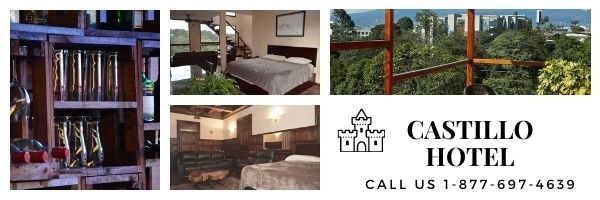That's very interesting (and disturbing) about the robberies of cyclists up in the mountains. I've heard that armed robberies of hikers is extremely common in places like the slopes of the Izalco Volcano of western El Salvador, but this is the first I've heard of cyclists being targeted in CR.
Those $100 per day group tours sound pretty pricey compared to doing it independently, but when you factor in all the other aspects it starts to look more and more like a real bargain. First, there is the obvious cost of renting the bike for the day (probably $20 or more). Then there is the cost of transportation out to whereever you're biking and back. It might be possible to do that by bus for fairly cheap but it will much more hassle than using a tour group provided van. Alternatively, one could use a rental car which will probably cost another $20/pp (for a group of 2 after figuring in gas, insurance and the additional cost of a rental bike rack), however, unless you start and stop in the same place (which would be impossible on a gravity run), that will add the problem of how to get back to your car after you get to the bottom. Next you add the less tangible benefit of having a sag wagon trailing behind you to pick you up in case you run into some trouble on the road (obviously does not apply to single track sections). And finally you add the potential loss of your rental bike which you'll probably be responsible for unless the outfitter offered some extra insurance for that (at an extra cost). On a group tour where they provide the bikes, the risk of stolen equipment probably falls on the group organizer rather than their customers. Also travelling in a tour group of 6-8 or more plus your tour guide (who, for all we know, may be "packing" himself) is much less likely to be targetted by crooks to begin with.
Re: your neighbor's account of the Conquistadores race. I'm quite impressed if he has done the whole race (or even any stage of it). And I'm absolutely sure he got it right about it not being for the faint of heart. However, you were actually understating it when you said it was "overnight" because it is actually a
race. Here is the complete race description from the
STAGES 2009
Day #1: Pacific Coast to Central Valley (Quinta del Sol)
Start Time: 05:00 a.m.
Closing Time: 05:30 p.m.
Distance: 110 km (68.7 miles).
Time to finish: 12 hours - 30 minutes at 8.8 km/h.
Climate: Tropical Rain Forest, Sub-Tropical Rain Forest and Tropical Dry Forest.
Last year's winning time: Federico "Lico" RamÃrez. T: 05:54:37.
The opening stage is traditionally the most difficult of La Ruta, with over 4400 meters of vertical climbing (14,500 feet), plus a trek through slippery and sticky mud, and multiple river crossings. The organizers now 'take it easy' on competitors by making the final climb on pavement, rather than the previous extremely steep gravel climb, but former world marathon champion Thomas Frischknecht (2005 La Ruta champion) still calls Day One the "the toughest single day of racing I have ever done".
The field pours out of the Pacific coast town of Jacó in the pre-dawn light, heading east, to finish in four days and 360 kilometers, on the Gulf side of Costa Rica. Within a few kilometers the race has left paved roads for first long dirt climb of over 10 kilometers, before the riders head into the Carara National Park.
The gaps get steadily bigger as riders succumb to the heat, the humidity and the relentless climbing, after exiting the Park and heading along gravel and paved roads to the finish at Ciudad Colon.
The French rider Thomas Dietsch, a marathon World Cup champion, waxed poetic about the section through Carara national park: "The walking part was so beautiful, incredible. I know you were supposed to be racing, but I wanted to look around. Going through the race forest, past all the rivers, I saw this big, big, blue butterfly ... it was a fantastic experience."
Canadian World Cup racer Kris Sneddon commented "Toughest race I've ever done. Makes Test of Metal and Checkamus look like a walk in the park."
------------------------------------------------------------------------------
Day #2: Central Valley (Quinta del Sol) to Tres RÃos (Terramall Shopping Center)
Start Time: 07:00 a.m.
Closing Time: 05:30 p.m.
Distance: 76 km (47.5 miles).
Time to finish: 10 hours - 30 minutes at 7.20 km/h.
Climate: Sub-Tropical Rain Forest, Template.
Last year's winning time: Paolo Montoya. T: 03:52:02.
Stage 2, while not the monster like stage 1, which often decimates the field, with over 20% of competitors missing the time cut, is still a hard, hard day of racing. Starting from Ciudad Colon west of San Jose, the 75.2 kilometer stage takes the riders in a long southerly loop around to the east of the capital. The opening three-kilometer dirt climb merely softens up the field, with a sketchy dirt descent taking riders to the base of the main climb, at 25 kilometers.
While this climb is paved, it was by no means easy, as French marathon champion Thomas Dietsch can attest to: "Climbs like this we do not see in Europe, with steep, steep sections and then a little flat and then steep,
steep again. It is very hard to ride these climbs, it takes much energy out of you." Over the top, it is a long gravel descent to the finish at Tres Rios, east of San Jose. Organizers have re-routed the race and the final section was turned into a technical descent through coffee plantation’s trails.
------------------------------------------------------------------------------
Day #3: Tres RÃos (Terramall Shopping Center) to Aquiares Turrialba
Start Time: 07:00 a.m.
Closing Time: 05:30 p.m.
Distance: 66.7 km (41.6 miles).
Time to finish: 10 hours - 30 minutes at 6.35 km/h.
Climate: Cloud Forest and Rain Forest. Wind and rain. Drastic climatic changes.
Last year's winning time: Federico "Lico" RamÃrez. T: 03:20:23.
Day three is when La Ruta hit its highest point, at 3010 meters above sea level on the slopes of the Irazú volcano. The mud quotient also decreases significantly from the first two stages.
The stage starts on the outskirts of San Jose and immediately begins to climb. After rolling through crowded city streets, the field stretches out quickly as the pavement tilts up.
Eight kilometers into the climb, riders entered a narrow green tunnel between three meters tall, moss covered dirt embankments topped by huge ferns and trees. The track has degenerated at this point to a pair of slippery cement pads the width of a car footprint, and is as steep as 18% in places.
Coming out of the tunnel the riders hit a short flat section of grass and mud before a final 20% singletrack grunt to the first checkpoint. After a short downhill respite, it is a solid 20 kilometers of climbing to the top of the climb. While the savagely steep sections of stage two are absent, mist, rain and the cold sap the strength of riders.
At the top, where volunteers meet shivering riders with hot tea (“Aguadulceâ€, an indian beverage made from sugar cane), it is 30 kilometers of gradual descending, with the first few kilometers the roughest. The final 15 kilometers is straight descending, with the last five switchbacking through coffee plantations to finish in the town of Aquiares (literally 'Surrounded by Rivers').
------------------------------------------------------------------------------
Day #4: Aquiares Turrialba to Limón (Reina’s Restaurant)
Start Time: 07:00 a.m.
Closing Time: 05:30 p.m.
Distance: 125 km (78.1 miles).
Time to finish: 10 hours - 30 minutes at 11.9 km/h.
Climate: Sub-Tropical Rain Forest, Montano Rain Forest and Tropical Forest.
Last year's winning time: Federico "Lico" RamÃrez and Paolo Montoya. T: 04:42:42.
The final day is the longest in distance, but possibly the easiest in terrain. Except for the opening five kilometers climb through the coffee plantation into which they descended the day before, there is only one other short climb in the 125 kilometers stage. The rest is gravel and paved descending for the first 55 kilometers, and then flat ground to the Gulf coast, where the riders turn south to head to the finish on the beach in Playa Bonita.
However, it is still no cakewalk... besides the kilometers of riding that have already made muscles deep-down weary, there is one final obstacle to be faced: the train tracks. Two long sections of train tracks - with rails and ties intact - force riders to choose between a bone jarring ride or squeezing along single file next to the tracks where possible. Add to that the long trestle bridges some 15 to 20 meters over fast flowing rivers that have to be navigated, and this is definitely not a 'cruise beside the beach'!
But, every rider who heads down the final ramp to slide to a stop on the sand in front of the crashing waves, can feel well satisfied that they are truly one of the Conquistadors of La Ruta.
By Robert Jones.
http://www.canadiancyclist.com









